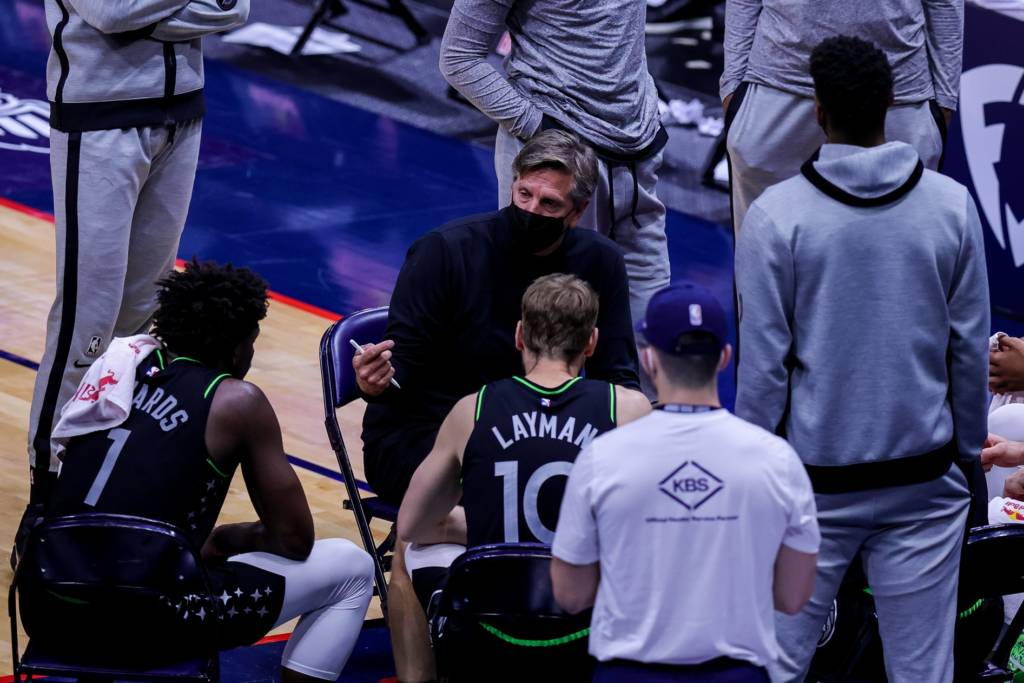Please join me for a Chris Finch statistical deep dive. Earlier this year, I wrote about how Gersson Rosas built the Minnesota Timberwolves roster for Finch to coach it, and now we’ve had a legitimate sample size to see how this team has transformed.
By Monday, Finch will have coached as many games as Ryan Saunders this season (31), so now we have close to an equal sample size to compare the two.
Net Rating

Just looking at the raw numbers alone, Finch looks terrible. His net rating is minus-7.4, while Saunders’ is an atrocious minus-6.7. The best argument for Finch right now is that the team is humming in the fourth quarter as well as any team in the league. Their fourth quarter net rating under Finch is 9.0. This means that the Wolves are outsourcing their opponents by nine points per 100 possessions in the fourth quarter — good for third in the league. On the other hand, Minnesota literally has the worst defensive rating since Finch has taken over (118.1).
Four Factors
One issue with NBA.com’s net rating is that it doesn’t filter out garbage time, and since the Timberwolves have played some of the most garbage time in the NBA, this filter is essential. Cleaning the Glass filters garbage time for us, so I looked at that to see if we see any trends in the four factors between the two coaching regimes:
After filtering out all of the garbage time where the reserves mounted half of a comeback under Saunders, the overall “efficiency differential” (point differential per 100 possessions) while Finch has been coach is actually 0.2 points greater.
However, the most significant takeaway here is that the Wolves shifted from 15th to second in free throw rate during the Finch era. This is one of the most underrated features of most good teams. They get to the line, and they make the freebies. The Timberwolves either improved or kept the same efficiency in each of the four factors on the offensive side of the ball, but the problem for this team comes on the defensive end.
Defense
The Timberwolves have had the worst defense in the league during Finch’s tenure, so I decided to find more detail from Cleaning the Glass once again. In what may come as a surprise, they improved their transition defense from 29th (4.3 points per 100 possessions) while Saunders was coach to 25th (3.8 points per 100 possessions).
Their problem on defense has been in the half-court, where the Wolves went from 11th (95.2 points per 100 possessions) to 29th (102.4 points per 100 possessions) since Finch took the reins.
Strength of Schedule
We have to factor in the strength of each of these coaches’ schedules as well. The first way I decided to calculate this is through the standard cumulative records for each split. The teams that Saunders coached against totaled 915-895, and the teams Finch has coached against are 884-807 this season, which gives him a higher opponent win percentage (50.6% to 52.3%, respectively).
This seems fairly negligible, but I also counted the amount of “winnable” games. I determined winnable games to be against any opponent with a winning record. Based on this, I found 17 of Saunders’ 31 games to be “winnable” (55% of games coached against losing teams), whereas Finch has only coached in 11 “winnable” games (38% of games coached against losing teams) thus far.
Strength of Roster (SoR)
The greatest contributing factor in the Timberwolves’ losing record this year is injury. Both coaches have dealt with tons of injury, and rather than counting the number of absences flat out, I decided to manufacture a weighted statistic I’m calling Strength of Roster (SoR).
For the sake of simplicity, I only counted Karl-Anthony Towns, D’Angelo Russell and Malik Beasley in the list of absences because these are the players most likely to affect winning (unless you’re talking to DLol, Malik, or KAT truthers). Because one game with Towns, DLo, and Malik is essentially equal to full competitiveness, I gave Karl a weight of 0.5, D’Angelo 0.3 and Malik 0.2.
After adding up all of the weighted games missed, factoring in the number of games coached for each coach, and inverting that number, my formula found that the difference in SoR between Saunders and Finch is negligible. Finch’s SoR has been 2.57, while Saunders’ was 2.33, which means that Finch has had about a 10% advantage in competitiveness. All things considered, this is far closer than one would think — especially given the early-season turmoil.
Overall, Finch has been the far superior coach to Saunders offensively and in the most important moments like non-garbage time and the fourth quarter. Minnesota’s half-court defense under Finch leaves much to be desired, but there are so many promising signs, especially late in close games. Given the significantly more difficult strength of schedule and a massive overhaul of strategy, I consider the first half-year under Finch a success.
He has proven that Rosas’ roster was made for him to coach it.




